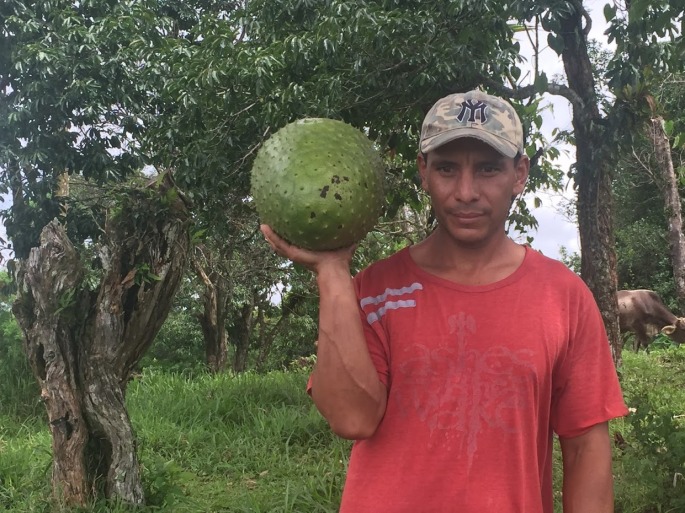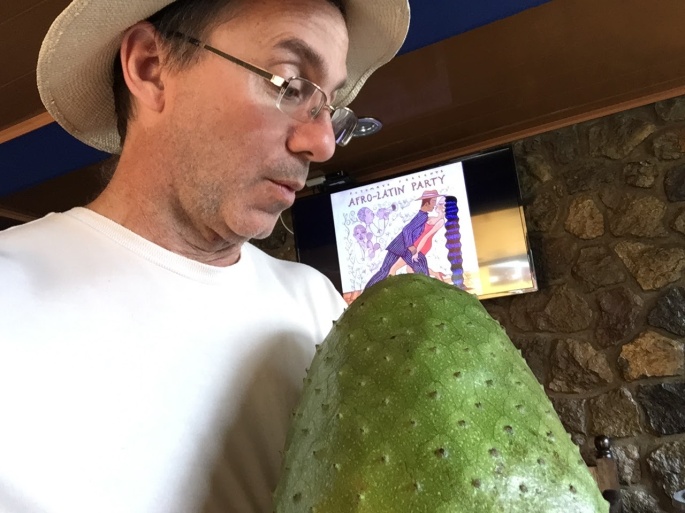Finding the right property at the right price had been my focus for so long that I only had a vague notion as to what we would do once we bought the place. That might sound strange, almost backwards. Shouldn’t one decide what to do and then find the optimum place to do it? Perhaps, and I certainly did have a wish list for the property, but in the end ‘the wand chooses the wizard, Mr. Potter’. Being a student of permaculture, once you have a property, the first thing you must do is observe. What does the land tell you? I had assumed that it would take months and many visits for us to understand what we should do, but as it turned out, we had that decision unknowingly made for us when the caretaker foisted an enormous prickly fruit into my hands. It was larger than a man’s head, looking like a thorny avocado on steroids.
 They explained to me it was a guyabana/guanabana/soursop/graviola and they were rather expensive. I’m holding the thing like someone gave me a screaming baby with a loaded diaper. It wasn’t until we had checked into our hotel that evening when I began to understand.
They explained to me it was a guyabana/guanabana/soursop/graviola and they were rather expensive. I’m holding the thing like someone gave me a screaming baby with a loaded diaper. It wasn’t until we had checked into our hotel that evening when I began to understand.
 To say the inn-keeper was enthusiastic at seeing our monster fruit is an understatement. He discussed the fruit at length, of all of the healing properties that the fruit, leaves, seeds and woody parts of the trees have. As he went on, the length the list of benefits stretched to the point of incredulity. Once his breathless dissertation finally found a pause, I offered it to him. He almost couldn’t believe it, and mentioned that a fruit of that size was worth at least $20. “Well, what the hell am I going to do with it?” I wondered aloud. I was too tired from the overnight flight to have offered to sell it to him and really the only thing I wanted to do was to chill in a hammock with a tall glass of ‘ron con hielo’. He offered to make us a smoothie the following day, but reported back that evening that the fruit needed a few more days to ripen and wouldn’t be ready for us to taste. He seemed to be forlorn than we did that we wouldn’t be able to taste it but as things turned out, we decided to go back to Boquete for the last two nights of our trip and stayed once more that the Boquete Central Hotel. He triumphantly prepared a guyabana smoothie for me and it was quite enjoyable. It was very thick with fiber and tasted of pear, pineapple and strawberry. The concoction used a bit of milk and raw cane sugar in addition to the guyabana. He offered me a second one, but was worried what it would do to my gut. Clearly this fibrous drink would hollow you out at an unexpected moment if you weren’t too careful with it.
To say the inn-keeper was enthusiastic at seeing our monster fruit is an understatement. He discussed the fruit at length, of all of the healing properties that the fruit, leaves, seeds and woody parts of the trees have. As he went on, the length the list of benefits stretched to the point of incredulity. Once his breathless dissertation finally found a pause, I offered it to him. He almost couldn’t believe it, and mentioned that a fruit of that size was worth at least $20. “Well, what the hell am I going to do with it?” I wondered aloud. I was too tired from the overnight flight to have offered to sell it to him and really the only thing I wanted to do was to chill in a hammock with a tall glass of ‘ron con hielo’. He offered to make us a smoothie the following day, but reported back that evening that the fruit needed a few more days to ripen and wouldn’t be ready for us to taste. He seemed to be forlorn than we did that we wouldn’t be able to taste it but as things turned out, we decided to go back to Boquete for the last two nights of our trip and stayed once more that the Boquete Central Hotel. He triumphantly prepared a guyabana smoothie for me and it was quite enjoyable. It was very thick with fiber and tasted of pear, pineapple and strawberry. The concoction used a bit of milk and raw cane sugar in addition to the guyabana. He offered me a second one, but was worried what it would do to my gut. Clearly this fibrous drink would hollow you out at an unexpected moment if you weren’t too careful with it.
I started researching the soursop fruit and what I found excited me. It’s been called a ‘super-fruit’, and while I do not know how valid these claims may be, I can say with a great degree of certainty that humans and the planet is certainly better off eating tree fruit than beef and dairy. So my cattle ranch will become an orchard. I commissioned the caretaker to germinate 1000+ soursop seedlings and I hope to plant them when I return in December.
The following comes from https://draxe.com/soursop/
- Filled with Beneficial Antioxidants that May Help Reduce Eye Disease
Many of the health benefits from graviola, or soursop, are thought to be derived from its antioxidant properties. Studies show that the phytonutrients that are found in the fruit are high in antioxidant compounds, including alkaloids, saponins, terpenoids, flavonoids, coumarins, lactones, anthraquinones, tannins, cardiac glycosides, phenols and phytosterols. This is quite a group that can help fight disease-causing cells and even tumors.
Additional studies have reported that antioxidants may help with eye disease. The Age-Related Eye Disease Study led by the National Eye Institute found antioxidants to be useful, especially when consumed as a cocktail of vitamin C, vitamin E, beta-carotene and zinc. This combination actually lowered the risk of the development age-related macular degeneration by 25 percent by those who already had the disease.
- Exhibits Anti-Inflammatory and Antimicrobial Properties
Extracts from graviola leaves have shown anti-inflammatory properties in addition to its antimicrobial characteristics, making soursop a versatile anti-inflammatory food. Studies indicate that soursop may be a natural anti-infection treatment for root canals. Often dangerous chemicals, such as sodium hypochlorite, which is actually a form of bleach, are used to irrigate the root canal to prevent infection. However, the dangers of these chemicals can pose health hazards. A study published in the Journal of Contemporary Dental Practice shows that the use of graviola to irrigate the root canal is very effective, making it a great, much healthier option.
- May Help Fight Cancer
Research published in Food & Function reports that bioactive components of graviola leaf extracts may have a positive cancer-fighting effect due to the free radical scavenging abilities and antioxidant enzymes it contains, thus helping eliminate cancer cells. (5) It’s believed that the graviola leaves kill cancer cells by blocking ATP production. ATP, aka adenosine triphosphate, is a usable form of energy for cells. This energy is contained within a chemical bond that, if released, can be used to foster other activity within the cells.
However, the graviola leaf extract can help block this activity, which may reduce the impact of the cancer cells by breaking them down until they fall apart. This is known as apoptosis or programmed cell death. Additionally, scientists at the Tepic Institute of Technology (Instituto Tecnológico de Tepic – ITT) in Mexico discovered acetogenins in the soursop fruit, which hold chemotherapeutic properties.
- Potentially Kills Pancreatic Cancer Cells
Graviola extract has shown an ability to help kill numerous types of cancer cells, specifically pancreatic cancer cells. A study conducted by the University of Nebraska Medical Center found that the extract can greatly reduce pancreatic cancer. Because cancer cells have more glucose, cell growth is typically enhanced as well as tumor growth. However, in this study, cells that were treated with graviola extract decreased their glucose uptake when compared to untreated cells. This decrease can make it difficult for the bad cells to live and multiply, which is a good thing.
- Treats Infections
Graviola is often used to treat infections caused by bacteria and parasites, including leishmaniasis, which is a disease that’s transmitted through the bite of sand fleas. It’s also been used to treat herpes, coughs and vomiting. Bacterial and viral infections can cause coughing, sneezing, fever and more symptoms, and while these symptoms may be frustrating, they’re effective since they’re part of the method that the body uses to trigger the immune system to get to work ridding the body of any infection. Graviola and graviola tea may be able to efficiently fight the infection and get you back on your feet.

I’ve had that smoothie in Vietnam! It was soooooooo goooooood. Healthy food never tasted better
LikeLiked by 1 person